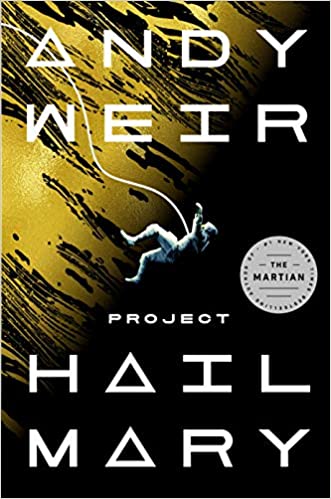
In my quest to find out how other science fiction writers have handled the subject of first contact with an alien race, I read Andy Weir’s new novel, Project Hail Mary. Most of you are probably familiar with Weir’s first novel, The Martian. That novel was a pleasure to read, if only because a first-time geeky author who liked technical intricacies was able to his self-published novel into a world-wide success, not to mention a Matt Damon film. His next novel, Artemis, showed that Andy Weir wasn’t just a science-nerd with phenomenal luck but was a genuine writer. In Hail Mary, Weir goes back to his techno-science details and mind-busting problems, similar to The Martian, and demonstrates that he has both developed a voice (nerdy, but wise-cracking— like the human and robot narrators of Mystery Science Theater 3000 if they were Ph.D. students in chemistry, physics and math), but can also develop mind-boggling plots involving real science applied to imaginary events. Isn’t this one definition of science fiction?
A microbe is siphoning off energy from our sun and using it to propel itself at near light-speed to Venus, where it absorbs CO2 and replicates, then it and its clone return to the sun to gather more energy, resulting in an exponentially increasing drain of energy from the sun that threatens to end all life on Earth. Not only that, every star but one in the nearby galaxy is suffering the same fate. Earthlings mount an exploratory manned vessel to travel to the one star that appears immune to the microbe to discover why this is so, hoping that the answer will provide a solution for Earth and our sun. In a nutshell, that’s the plot. What happens is that the geek scientist from Earth and a gifted mechanical engineer from another star system arrive at the star at the same time, both of them the only surviving members of their crews. They must learn enough about each other to work together to find an answer to their respective home planets’ dilemmas. What a cool plot! I told my wife this plot and she thought I was describing my next novel and told me I was a genius and sure to write a best-seller. I felt bad telling her that it was too late, it had already been done by Andy Weir.
Hail Mary is a best-seller and gets overwhelmingly positive reviews on Amazon and elsewhere. Although I agree with the rave reviews 100%, I’m a little surprised, and a lot encouraged to find that so many readers enjoy reading about real science and how real scientific and technological problems can be solved by a lot of knowledge and a lot of creativity. This novel is one scientific or technical dilemma after another and the characters arrive at solutions using science and math—no wizards, sorcerers, magic, alternative mental states, or any of the tropes that characterize much of what passes for science fiction today. What a relief! I was reminded of Kim Stanley Robinson, Arthur C. Clarke, Fred Hoyle, and others who draw on real science for the basis for their novels.
This is a novel, with likeable characters, including the alien, moral dilemmas, human failings, and the story of how someone with such failings manages to put the future of humanity above his own needs and friendship above self-preservation. It’s a wonderful example of real science fiction. You’ve got to read it. I’m glad that I did.
What did I learn about aliens from Weir’s novel? The most valuable message was probably to let my imagination go and think beyond oxygen-breathing, anthropoid-looking creatures. Rocky, the alien in HailMary, looks like a spider, has no head and no eyes, and is oriented toward sound and touch. He weighs about 800 pounds and talks by making music. In what is a real tradition-breaking idea, Weir has his star-traveling alien race having never discovered radiation or relativity or even digital computing. We forget that early science fiction rarely incorporated quantum physics or computers yet gave plausible accounts of interstellar travel. How far could a race get without our science? It’s a good question. I didn’t get any concrete ideas, and I wouldn’t want to copy Weir’s ideas anyway, but reading Hail Mary did open my mind to the range of possibilities available for constructing an alien race. To find out what I did come up with, you’ll have to read the sequel to Ezekiel’s Brain when I finish writing it and it gets published.
Project Hail Mary is available on Amazon HERE
Ezekiel’s Brain may be purchased through Amazon by clicking HERE
Want to subscribe to Casey Dorman’s fan newsletter? Click HERE.





